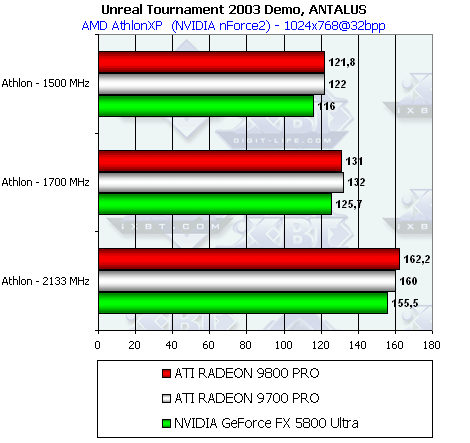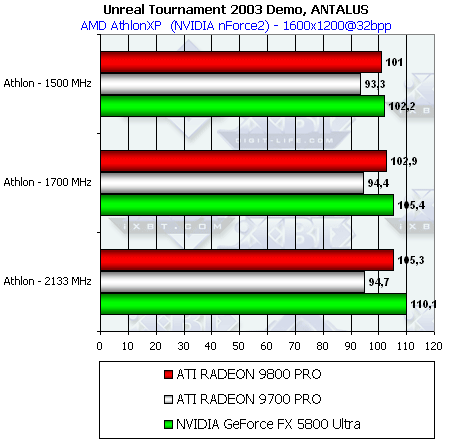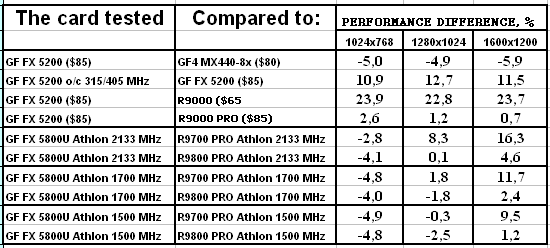Gainward FX Powerpack Ultra/1000 Golden Sample
(NVIDIA GeForce FX 5800 Ultra) &
Gainward FX Powerpack Pro/660 TV/DVI
(NVIDIA GeForce FX 5200) Video Cards Review
|

CONTENTS
-
General
information
-
Video
card features
-
Test
system configuration
-
Test
results
-
Conclusion
As we keep on studying new solutions from NVIDIA, I must say that it
is not latecomer NV30 (GeForce FX 5800) which comes to the forefront this
spring. Today the attention is focused on the new line supporting DX9 which
is positioned for budget and mainstream sectors. These video cards will
be the most interesting for the majority.
ATI launched similar accelerators for the mainstream market (RADEON
9500/PRO) half a year ago. But the sub-$100 sector is burdened with old
solutions. The only processor that ATI has there is RADEON 9000 which brought
DX81 into the budget sector. But as you are well aware, even the most favorable
market conditions do not stimulate the Canadian company to carry out the
aggressive policy. It always stumbles over something: bad drivers, shortage
of chips, shortage of common sense... That is why GeForce4 MX, though a
weaker runner, is still much more popular with users than the advanced
RADEON 9000.
But time goes on, and even non-advanced users realize how weak GF4MX
is in supporting shaders and other modern functions, and the year of 2003
is the high time to do away with this anachronism. That is why the market
is now filling with inexpensive GeForce FX 5200 based video cards. One
of such cards will be tested today. GeForce FX was already studied in our
previous reviews:
That is why we won't dwell on technical parameters and quality issues of
3D functions.
Today I'm going to look at two aspects: for GeForce FX 5800 Ultra (Gainward's
card) - video card performance vs. CPU clock speed; for GeForce FX 5200
- comparison of performance of this card with RADEON 9000/PRO and GeForce4
MX 440-8x.
Gainward is an established brand on the market, especially its Golden
Sample series which includes samples which run reliably at a little overclocked
speed or which are bundled with peculiar accessories. Briefly, the company
is headquartered in Taiwan for over 20 years, but earlier it dealt with
OEM orders only. As an independent manufacturer and seller of its products
under PowerPack trademark (earlier CARDexpert) it rang out quite recently.
Today we are testing two cards: the top solution in the GeForce FX line
- 5800 Ultra, and the lowest one - 5200. The former is meant for $350+
niche while the latter is positioned for the sub-$100 market sector. Both
accelerators differ only in the speed characteristics (GeForce FX 5200
has only one restriction in AA - 4xS, in contrast to 8xS of 5800).
But they are far different in the appearance and design.
Cards
| Gainward FX Powerpack Ultra/1000 Golden Sample |

|

|
| Gainward FX Powerpack Pro/660 TV/DVI |

|

|
| Gainward FX Powerpack Ultra/1000 Golden Sample |
| The card has AGP x2/x4/x8 interface, 128 MB DDR
SDRAM (8 chips on both PCB sides). 128bit memory exchange interface.
Samsung K4N26323AE-GC1K,
memory chips of BGA form-factor. Maximum clock speed is 550 (1100) MHz,
hence 1.8 ns access time. The memory works at 500 (1000) MHz in 3D and
at 300 (600) MHz in 2D. |

|
| Gainward FX Powerpack Pro/660 TV/DVI |
| The card has AGP x2/x4/x8 interface, 128 MB 128bit memory
chips.
Samsung memory chips of TSOP form-factor. 5ns access time. It corresponds
to 200 (400) MHz, and the memory works at this clock speed. The core is
clocked at 250 MHz. |

|
| Comparison with the reference design, front view |
| Gainward FX Powerpack Ultra/1000 Golden Sample |
Reference card NVIDIA GeForce FX 5800 Ultra |

|

|
| Gainward FX Powerpack Pro/660 TV/DVI |
Reference card NVIDIA GeForce FX 5200 Ultra |

|

|

|
| Comparison with the reference design, back view |
| Gainward FX Powerpack Ultra/1000 Golden Sample |
Reference card NVIDIA GeForce FX 5800 Ultra |

|

|
| Gainward FX Powerpack Pro/660 TV/DVI |
Reference card NVIDIA GeForce FX 5200 Ultra |

|

|
|
Gainward's GeForce FX 5800 Ultra is a copy of the reference card, but
for the cooler. GeForce FX 5200 differs much from the reference 5200 Ultra
based card. This is not the Ultra version, and the PCB looks much plainer.
At the same time, the design of 5200 follows the reference one in every
detail:

As you can see, GF FX 5200 comes with the outdated 5ns memory. If you remember,
even GeForce4 MX had 4ns in most cases (I don't mean numerous noname MX440SE
cards with 6ns and 7ns memory). This is obviously the cost of 128 MB, and
I'm sure that 64MB GF FX 5200 cards will have 4ns memory.
Therefore, overclocking of such memory (5ns, Samsung) is hardly possible.
Now have a look at the coolers. |
| Gainward FX Powerpack Ultra/1000 Golden Sample |
| This cooler is a zest of this card. It looks like NVIDIA's
FlowFX, but here air is sucked in from inside the PC case, not from the
outside, and an air flow doesn't make such a sudden turn in the plastic
tube like in FlowFX, and, therefore, makes less noise.
But this cooler has its own downsides:
-
Although the cooler is less noisy, the noise frequency is higher because
of the speedy fan, and you can hear it whistling (owners of computers with
SCSI hard drives of 10000 and over rpm are well aware of it :-).
-
Air is taken from inside the PC case which makes cooling less effective.
Besides, the cooler still switches on/off depending on the graphics mode
(2D/3D) and GPU's temperature, though it would be better if a user could
decide himself whether to allow such reswitching or not. Such changes irritate
much. |

|

|

|

|
| Gainward FX Powerpack Pro/660 TV/DVI |
| This card has only a passive pin heatsink, which is sufficient for
such frequencies (250 MHz). |

|
Under the heatsink we can find the processor itself:

I tried the TV-out of GF FX 5200 and found it pretty good. Aleksei Samsonov
and Dmitry Dorofeev, our experts in this sphere, will soon provide more detailed
information on this aspect in the updated material
on TV-out of GeForce2/3/4 based cards.
Accessory packs:
|
| Gainward FX Powerpack Ultra/1000 Golden Sample |
| This bundle is luxurious. Here you can find a user guide,
CD with drivers and utilities, CDs with outdated (unfortunately) games
and WinDVD 4.0, S-Video-to-RCA and DVI-to-d-Sub adapters, and TV-out extenders.
The most peculiar thing is a 5.1-channel sound card (but I think that
those who can afford a card of $400-450 won't need such cheap sound; they'd
better go with something like Creative Audigy(2))
Also, there is a FireWire controller, which comes in handy here, because
users buying such expensive accelerators usually have digital video cameras. |

|

|

|

|

|

|

|
| Gainward FX Powerpack Pro/660 TV/DVI |
| Here we have a user guide, CD with drivers and utilities, WinDVD 4.0,
S-Video-to-RCA adapter, TV-out extenders, and DVI-to-d-Sub adapter. |

|
| Both cards ship in retail packages. |
| Gainward FX Powerpack Ultra/1000 Golden Sample |
| The designers at Gainward have finally invented something new. This
time they put on the box a pretty, though rendered, girl. |

|
| Gainward FX Powerpack Pro/660 TV/DVI |
| But I think it's wrong to use the same box for so different cards,
in spite of the same line. One sticker with the card's name is not enough. |

|
Overclocking
| Gainward FX Powerpack Ultra/1000 Golden Sample |
The overclocking is not fruitful - after 540 MHz the chip hangs,
while the memory's summit is only 1040 MHz. |
| Gainward FX Powerpack Pro/660 TV/DVI |
While the chip goes up noticeably - up to 315 MHz, the memory
has clambered up to 405 MHz from 400 MHz. Later you will see that the card's performance
is much limited by the memory, and GPU alone does not boost the performance. |
Note that
-
Overclocking requires additional card cooling (for its memory, in particular):

-
Overclocking depends on a certain sample, and you shouldn't extend single-card
results to the entire series or trade mark. Overclocking results are not
obligatory characteristics of video cards.
Testbed and drivers
Testbed:
-
Pentium 4 3066 MHz based computer:
-
Intel Pentium 4 3066 MHz;
-
ASUS P4G8X (iE7205) mainboard;
-
1024 MB DDR SDRAM;
-
Seagate Barracuda IV 40GB hard drive;
-
Windows XP SP1; DirectX 9.0;
-
ViewSonic P810 (21") and ViewSonic P817 (21")
monitors.
-
NVIDIA's drivers v43.45.
-
Athlon XP 2600+ based computer:
-
AMD Athlon XP 2600+ (2133 MHz);
-
EPoX (nForce2) mainboard;
-
1024 MB DDR SDRAM PC3200;
-
Seagate Barracuda IV 40GB hard drive;
-
Windows XP SP1; DirectX 9.0.
-
ViewSonic P810 (21") and ViewSonic P817 (21")
monitors.
-
NVIDIA's drivers v43.45.
VSync off in drivers, texture compression off in applications. Texture
detail set to High Quality.
Video cards for comparison:
-
Gainward Powerpack Pro/650 (GeForce4 MX440-8x, 275/256 (512) MHz, 64 MB);
-
Hercules 3D Prophet 9000 PRO (RADEON 9000 PRO, 275/275 (550) MHz, 128 MB,
driver 6.307);
-
Sapphire Atlantis RADEON 9000 (RADEON 9000, 250/200 (400) MHz, 128 MB,
driver 6.307)
-
Hercules 3D Prophet 9700 PRO (RADEON 9700 PRO, 325/310 (620) MHz, 128 MB,
driver 6.307);
-
ATI RADEON 9800 PRO (380/340 (680) MHz, 128 MB, driver 6.307).
Test results
Before we start examining 2D quality, I should say there are no complete
techniques for objective 2D quality estimation because:
-
2D quality much depends on certain samples for almost all modern 3D accelerators;
-
Besides videocards, 2D quality depends on monitors and cables;
-
Moreover, certain monitors might not work properly with certain video cards.
As for the sample tested, together with the ViewSonic P817 monitor and
BNC Bargo cable it showed excellent quality at the following resolutions
and clock speeds:
| Gainward FX Powerpack Ultra/1000 Golden Sample |
1600x1200x85Hz, 1280x1024x120Hz, 1024x768x160Hz |
| Gainward FX Powerpack Pro/660 TV/DVI |
1600x1200x85Hz, 1280x1024x120Hz, 1024x768x160Hz |
3D performance
Test applications:
-
Quake3 Arena v.1.17 (id Software/Activision) - OpenGL, multitexturing,
Quaver,
test settings - maximum: detailing level - High, texture detailing
level - #4, S3TC OFF, smoothness
of curves is much increased through variables r_subdivisions "1"
and r_lodCurveError "30000" (at default r_lodCurveError is
250 !), the configurations can be downloaded from
here
-
Return to Castle Wolfenstein (MultiPlayer) (id Software/Activision) - OpenGL,
multitexturing, Checkpoint-demo,
maximum test settings, S3TC OFF, the configs are available here
-
Serious Sam: The Second Encounter v.1.05 (Croteam/GodGames) - OpenGL, multitexturing,
Grand Cathedral demo, test settings: quality, S3TC OFF
-
Unreal Tournament 2003 Demo v.1077 (Final Release) (Digital Extreme/Epic
Games) - Direct3D, Vertex Shaders, Hardware T&L, Dot3, cube texturing,
default quality
-
3DMark2001 Pro (MadOnion/Remedy) - DirectX 8.0, Hardware
TCL, Game1, Game2, Game3, Game4; Low, High detail levels
-
RightMark 3D (one of the game scenes) - DirectX 8.1, Dot3, cube texturing,
shadow buffers, vertex and pixel shaders (1.1, 1.4).
Today we have two aspects for analysis:
-
Performance of GeForce FX 5800 Ultra vs. CPU's frequency (AthlonXP);
-
Comparison of performance of GeForce FX 5200 without AA and anisotropy
enabled.
3D graphics, 3DMark2001 game tests
3DMark2001, 3DMARKS





3DMark2001, Game1 Low details





3DMark2001, Game2 Low details





3DMark2001, Game3 Low details





3DMark2001, Game4





I guess, it's clear how NV30's performance depends on the CPU's clock speed,
and you can draw the conclusion yourselves.
In most cases GeForce FX 5200 lags behind GeForce4 MX440-8x running
between RADEON 9000 and 9000 PRO. It's quite fair for the configuration
with two 2 texture units and the frequency of 250 MHz in contrast to 4
texture units and 275 MHz of MX440-8x. GeForce FX 5200 works at the same
frequency as RADEON 9000 but it performs better. Besides, being a flexible
system, it depends much on optimization of the drivers. That is why the
speed can grow even more.
3D graphics, game tests
Quake3 Arena





Serious Sam: TSE





RtCW





UT2003 DEMO





Rightmark 3D v.0.4





Sometimes GeForce FX 5200 loses even to RADEON 9000, but sometimes its
performance is really superb. I think NVIDIA will keep on polishing the
drivers, and the vendors should think about cutting prices for such cards
to create the demand and to make users forget about such an anachronism
as GeForce4 MX.
In closing I must say that both cards worked perfectly, and had no problems
with stability.
Conclusion
Such cards as GeForce FX 5200 can be good substitutes for GeForce4 MX,
and they successfully fight against RADEON 9000. The manufacturers had
better replace 128 MB memory with 64MB and reduce the sale prices. The
sellers should realize that this is not GeForce FX 5800, but only its shadow
bundled with all the same functions. This accelerator can be competitive
only for GeForce4 MX and RADEON 9000. This fact should be accounted for
in the price.
On the one hand, GeForce FX 5800 Ultra is a solid card with a striking
accessory pack. But some accessories are not needed for users, and the
cooler produces irritating high-pitch noise, though it actually works quieter.
Let's wait and see what the prices are going to be. I must say that NVIDIA
keeps on optimizing its drivers, and NV30 has already raised its speed.
But there are still problems with AA: certain AA modes do not work in some
games or they are replaced with lower ones.
Highs:
-
Almost the best 3D performance among the today's accelerators which are
already available for buyers (I mean GeForce FX 5800 Ultra);
-
GeForce FX 5200 has performance comparable to GeForce4 MX 440 and RADEON
9000 (also remember that it supports all kinds of shaders);
-
High build quality;
-
Stable and reliable operation;
-
A rich accessory pack of Gainward's GeForce FX 5800 Ultra (though some
of the accessories are not needed)
Lows:
-
Irritating noise of the cooler of GeForce FX 5800 Ultra;
-
GeForce FX 5800 Ultra is in short supply and overpriced;
-
Overpriced GeForce FX 5200 (for the beginning);
-
Unnecessary 128 MB on FX 5200 (64MB and faster memory would be better;
at least, overclockers would like it :-)
Write a comment below. No registration needed!
|
|
 |
|
|
|




















































